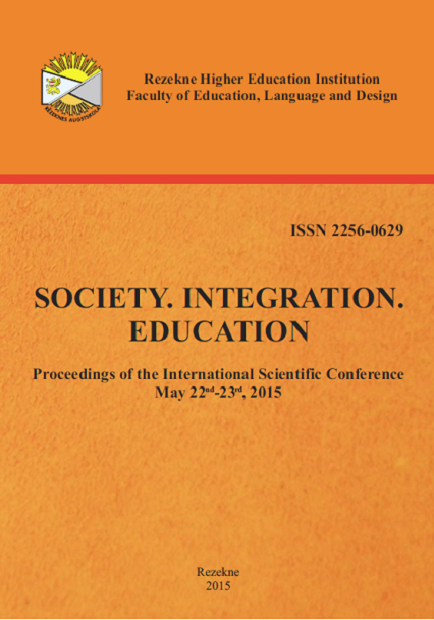Exploring the Association between Adolescents Participation in Sport and Their Attachment to Parent and Peer
DOI:
https://doi.org/10.17770/sie2015vol3.482Keywords:
adolescent attachment with parents, attachment with peer, participation in sport, positive youth development in sportsAbstract
This qualitative cross-sectional design study examine the association between adolescents’ participation in sports activities and their attachment with parents and peers. A total of 1348 (716 female and 632 male) aged 12 to 16 completed questionnaire assessing attachment with parent and peer (trust, communication, alienation). This study showed that adolescents not participating in sports scored significantly lower on all Parent Attachment subscales when compared to adolescent athletes. The research also revealed that participation in sports has an effect on both Trust in Peers and Alienation from them. Boys scored significantly higher than girls did on Trust and Alienation with parents, while girls scored significantly higher than boys in terms of Peer attachment. Younger adolescent scored significantly higher on the Parent Attachment scale whereas senior adolescents scored higher on Trust with Peer.
References
Abraham, M. M, Kerns, K. A. (2013). Positive and negative emotions and coping as mediators of mother-child attachment and peer relationships. Merrill-Palmer Quarterly, 59, 399–425.
Ainsworth, M. D. S, Blehar, M. C, Waters, E, Wall, S. (1978). Patterns of attachment: A psychological study of the strange situation. Hillsdale, NJ: Erlbaum.
Arnon, S., Shamai, S., Illatov, Z. (2008). Socialization agents and activities of young adolescents. Adolescence, 43, 373‑397.
Bailey, R., Cope, E.J., Pearce, G. (2013). Why do children take part in, and remain involved in sport? A literature review and discussion of implications for sports coaches. International Journal of Coaching Science, 7, 56‑75.
Bowlby, J. (1969). Attachment and loss. New York, NY: Basic Books.
Cai, M., Hardy, S. A., Olsen, J. A., Nelson, D. A., Yamawaki, N. (2013). Adolescent-parent attachment as a mediator of relations between parenting and adolescent social behavior and wellbeing in China. International Journal of Psychology, 48, 1185–1190.
Carr, S. (2009). Adolescent-parent attachment characteristics and quality of youth sport friendship. Psychology of Sport & Exercise, 10, 653–664.
Carreres‑Ponsoda, F., Carbonell, A.E., Cortell‑Tormo, J.M., Fuster‑LLoret, V., Andreu‑Cabrera, E. (2012).The relationship between out-of-school sport participation and positive youth development. Journal of Human Sport & Exercise, 7, 671‑683.
Clarke, N. J., Harwood, Ch. G. (2014). Parenting exercise experiences in elite youth football: A phenomenological study. Psychology of Sport and Exercise, 15, 528‑537.
Dykas, M. J., Ziv, Y., Cassidy, J. (2008). Attachment and peer relations in adolescence. Attachment and Human Development, 10, 123–141.
Dorsch, T. E., Smith, A. L., McDonough, M.H. (2009). Parents’ perceptions of child-to-parent socialization in organized youth sport. Journal of Sport and Exercise Psychology, 31, 444–468.
Engels, R., Dekovic, M., Meeus, W. (2002). Parenting practices, social skills and peer relationships in adolescence. Social Behavior and Personality, 30, 3-18.
Fredricks, J. A., Eccles, J. S. (2010). Breadth of extracurricular participation and adolescent adjustment among African-American and European-American youth. Journal of Research on Adolescence, 20, 307‑333.
Gentzler, A. L., Ramsey, M. A., Yuen Y. C., Palmer, C. A., Morey, J. N. (2014). Young adolescents’ emotional and regulatory responses to positive life events: investigating temperament, attachment, and event characteristics. Journal of Positive Psychology, 9, 108–121.
Gullone, E., Robinson, M. (2005). The Inventory of Parent and Peer Attachment-Revised (IPPA-R) for Children: A Psychometric Investigation. Clinical Psychology and Psychotherapy, 12, 67–79.
Imtiaz, S., Naqvi, I. (2012).Parental attachment and identity styles among adolescents: Moderating role of gender. Pakistan Journal of Psychological Research, 27, 241-264.
LaVoi, N. M., Stellino, M. B. (2008). The influence of perceived parent created sport climate on competitive youth male hockey players’ good and poor sport behaviors. Journal of Psychology: Interdisciplinary & Applied, 142, 471-495.
Malinuevo, B., Bonillo, A., Pardo, Y., Doval, E., Torrubia, R. (2010).Participation in extracurricular activities and emotion and behavioral adjustment in middle childhood in Spanish boys and girls. Journal of Community Psychology, 38, 842‑857.
Nawaz, S. (2011). The relationship of parental and peer attachment bonds with the identity development during adolescence. Journal of Social Sciences, 5, 104–119.
Palomo-Nieto, M., Rui-Pérez, L. M., Sánchez-Sánchez, M., García-Coll, V. (2011).Young athletes’ perceptions of the role of their mothers in their sport career.European Journal of Human Movement, 26, 141-157.
Sánchez-Miguel, P. A., Leo, F. M., Sánchez-Oliva, D. et al. (2013). The Importance of parents’ behavior in their children’s enjoyment and amotivation in sports. Journal of Human Kinetics, 36, 171–179.
Tomik, R., Olex-Zarychta, D., Mynarski, W. (2012). Social values of sport participation and their significance for youth attitudes towards physical education and sport.Studies in Physical Culture and Tourism, 19, 99-104.
Van Petegem, S., Beyers, W., Brenning, K., Vansteenkiste, M. (2013). Exploring the association between insecure attachment styles and adolescent autonomy in family decision making: A differentiated approach.Journal of Youth and Adolescence, 42, 1837–1846.
Zbarauskaitė, A. (2011). Prieraišumas: Iššūkiai ir galimybės globojant vaiką ir paauglį. Vilnius: Valstybės vaiko teisių apsaugos ir įvaikinimo tarnyba.






